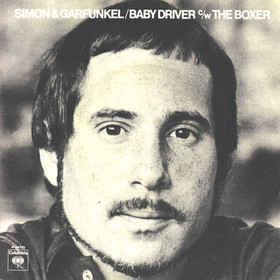- The Boxer
Single infobox
Name = The Boxer
Writer =Paul Simon

Artist =Simon and Garfunkel
from Album =Bridge over Troubled Water
Released = April, 1969
Format =7" single
Recorded = 1969
Genre =Folk rock
Length = 5:10
Label =Columbia Records
Producer =Roy Halee ,Paul Simon ,Art Garfunkel
Last single = "Mrs. Robinson " (1968)
This single = "The Boxer" (1969)
Next single = "Bridge over Troubled Water" (1970)"The Boxer" is afolk ballad written byPaul Simon in 1968 and first recorded bySimon and Garfunkel . It was released as the follow up single to their number one hit "Mrs. Robinson ", and reached #7 in the US charts. It later appeared on their last studio album, "Bridge over Troubled Water ", along with itsB-side "Baby Driver". It is particularly known for its plaintiverefrain , in which the singer sings the tune as 'lie-la-lie', and the memorable finger-picking guitar played by guitaristFred Carter, Jr. . "Rolling Stone " ranked the song #105 on their list ofthe 500 Greatest Songs of All Time .Creation and recording
The original recording of the song is one of the duo's most highly produced, and took over 100 hours to record. The recording was performed at multiple locations, including Nashville, St. Paul's Church in New York city, and Columbia studios. Drummer
Hal Blaine created the huge drum sound heard during the chorus by banging a heavy chain against the concrete floor of an empty storage closet.The version originally released on single by the duo features an instrumental melody written by
Art Garfunkel Fact|date=May 2008 and played in unison onpedal steel guitar and piccolo trumpet. The song also features abass harmonica heard during the second and final verses.The song was originally and performed in the key of B Major, but due to tape-speed variation, sounds about a quarter of a semitone closer to C Major.Fact|date=May 2008
Lyrics
The song's lyrics take the form of a first-person lament, as the singer describes his struggles to overcome loneliness and poverty in
New York City . The final verse switches to a third-person sketch of a boxer, who, despite the effects of "every glove that laid him down or cut him 'til he cried out", perseveres.It is sometimes suggested that the lyrics represent a "sustained attack on
Bob Dylan ".Baker, G.A. Sleeve of "Simon and Garfunkel: 20 Greatest Hits"] Bob Dylan thought the song was about himFact|date=May 2008, in turn covering it on his "Self Portrait" album. Yet Paul Simon himself has suggested that the lyrics are largely autobiographical, written during a time when he felt he was being unfairly criticized:"I think I was reading the Bible around that time. That's where I think phrases such as 'workman's wages' came from, and 'seeking out the poorer quarters'. That was biblical. I think the song was about me: everybody's beating me up, and I'm telling you now I'm going to go away if you don't stop." [http://freespace.virgin.net/r.kent/quotes.html (unsourced WWW page)]
The chorus of the song is wordless, consisting of a repeated chant of "lie-la-lie". Simon stated that this was due to a lapse on his part:
"I didn't have any words! Then people said it was 'lie' but I didn't really mean that. That it was a lie. But, it's not a failure of songwriting, because people like that and they put enough meaning into it, and the rest of the song has enough power and emotion, I guess, to make it go, so it's all right. But for me, every time I sing that part... [softly] , I'm a little embarrassed." [http://www.ckk.chalmers.se/guitar/the.boxer.html (dead link)]
"Missing" verse
"The Boxer" was originally written with a verse that is not present in the "Bridge Over Troubled Water" version:
Now the years are rolling by me They are rocking evenly And I am older than I once was And younger than I'll be, but that's not unusual. No, it isn't strange After changes upon changes We are more or less the same After changes we are more or less the same
This "missing verse" was performed by Simon and Garfunkel when they went on tour in November 1969, and Paul Simon when he performed it solo after the group's breakup. Simon and Garfunkel also performed the "missing verse" on "
Saturday Night Live " in 1975Fact|date=September 2007 and when they reunited for "The Concert in Central Park " in 1981, and onLate Show with David Letterman .Subsequent versions
Me First and the Gimme Gimmes ,Bob Dylan ,Emmylou Harris ,The Samples , andAcross The Border have recordedcover version s of the song, with Harris' version reaching the top ten on the US country charts in June 1980.Joan Baez has also made the song a staple of her live concert performances, from the late 1970s to the present. (Baez usually includes the above-mentioned missing verse in her version.) TheKing's Singers released ana cappella version on their "Good Vibrations" album in 1992. Guitar virtuosoChet Atkins recorded an instrumental version, in which each verse was played on a different guitar and in a different style.The song has also been included in several live Simon and Garfunkel recordings. On "" keyboardist Rob Schwimmer plays the Garfunkel tune on a
Theremin .Simon sang the song to open "
Saturday Night Live " onSeptember 29 ,2001 , the first live SNL show following theSeptember 11 ,2001 attacks onNew York City .References
Wikimedia Foundation. 2010.
